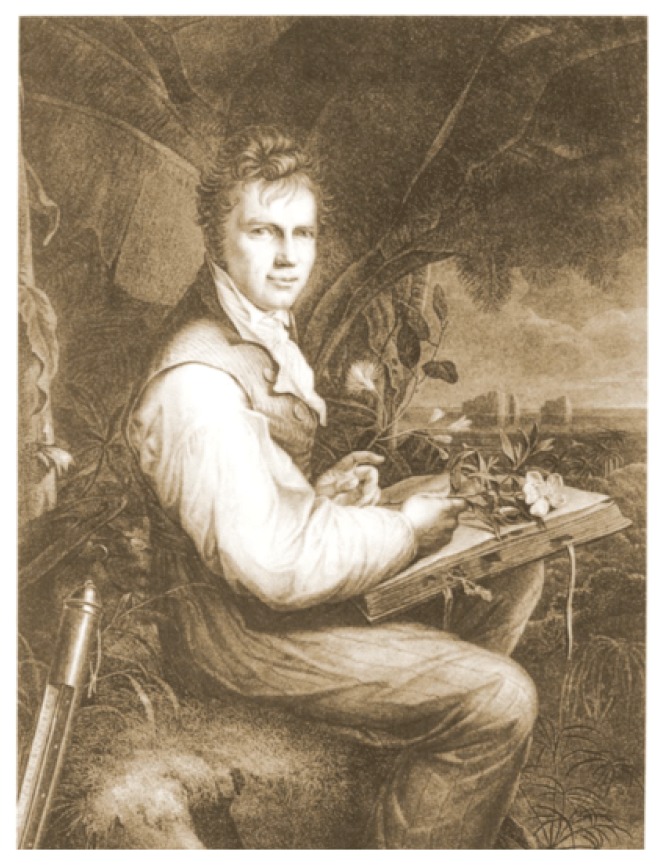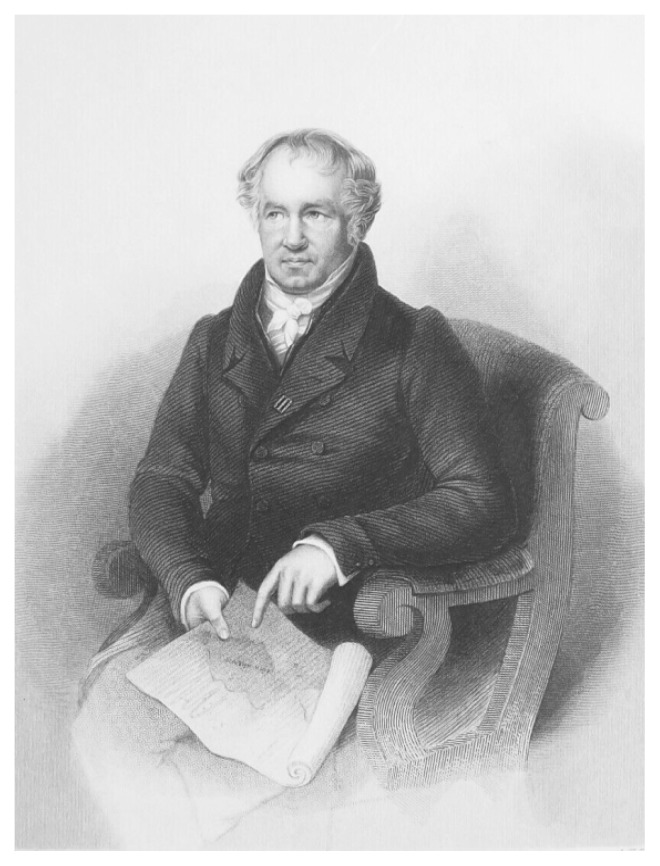Abstract
Alexander von Humboldt (1769–1859) is one of the most prominent Germans. His multidisciplinary activity set standards to science at the beginning of modern era. His personality is celebrated worldwide. The Alexander von Humboldt Foundation in Bonn is still preserving his memory and endorsing research in all the fields. This paper is a historical sketch presenting his contributions to the development of medical sciences and also to the progress of scientific illustrations. We also introduce personalities of the Cluj-Napoca medical school who were fellows of the Alexander von Humboldt Foundation.
Keywords: Alexander von Humboldt, biomedicine, imaging, morphology
Introduction
Alexander von Humboldt (1769–1859) is one of the most important and influential personalities in German culture. A real scientist doubled by a ”Schöngeist”, he left an impression during his time and until nowadays due to his dynamic, successful and very mobile life, as well as by his tremendous achievements in many fields of science and social life. Indeed he was an explorer, an adventurous pioneer, a spirit passionate by experimentations, a diplomat and politician, a prolific writer [1,2]. Much less is known by his interest in biomedical and morphological issues, matters that we will present in this historical sketch.
Biography of Alexander von Humboldt
Alexander von Humboldt was born 250 years ago, on 14 September 1869 in Berlin, in a family of a Prussian officer. He had an older brother who became also very famous: Wilhelm von Humboldt (1767–1835). Wilhelm had also an outstanding life and career as philosopher and linguist. The University of Berlin bears his name [3].
Receiving a very good education thanks to his ambitious mother, Alexander developed his passion for biology, classification and uncovering the secrets of nature by assembling a large collection of medicinal plants and insects even as teenager. Later he became a student in Göttingen, where he met the naturalist Georg Forster (1754–1794), who accompanied James Cook in his journeys. Forster inspired the wish of Humboldt to travel and together undertook some journeys in Europe collecting different data on plants, fauna and minerals. His interest in mineralogy and its use for human use led him to the Mining School of Freiberg which he graduated 1793 [1,3].
Further on, he started several expeditions in Latin America: Venezuela, Cuba, and Mexico between 1799–1804, where he explored far regions like Orinoco River. He was accompanied by the French naturalist and physician Aimé Bonpland during this five-years journey. In 1804 he visited the United States and met Benjamin Franklin. Much later he undertook a similar very long trip to Russia and as far as Mongolia, largely supported by the tsar.
His main work remains the five volumes of “Kosmos”, appeared between 1847–1860 (last volume was posthumous). This is a real magna opera including a synthesis of all his works on natural sciences, geography, and mankind. This book contributed to his worldwide reputation of explorer and friend of main sovereigns of the world. He was also friend or in correspondence with major contemporary personalities, and Goethe himself was very much impressed by Alexander von Humboldt. He also influenced the works of Darwin and Haeckel. His achievements were obtained thanks to his curiosity, versatility and not least, to his impressive working capacity. He used to sleep only 2 hours per day and could work intensively [4].
He died at the age 90 years in Berlin because of a cerebrovascular disease, in full glory. It was recorded that his last words were: “how glorious are these sunbeams”.
His life and work are remembered now by many Humboldt schools and institutions in the world from Germany to Latin America. The most prestigious is the Alexander von Humboldt Foundation in Germany. This foundation was first launched in the German empire to support exploring travels to Latin America. But after the World War 2 it was refunded in 1953 as Foundation supported by the German Foreign Affairs Ministry to stimulate scientific and artistic cooperation with other countries. The main task of the Alexander von Humboldt Foundation is to offer very prestigious research grants (about 500 per year, any discipline) to postdocs to come and spend research time in Germany.
The portrait of Humboldt is very familiar and can be seen on stamps, coins, banknotes of many countries. We present two portraits of Alexander von Humboldt on old lithographs from a private collection from Cluj-Napoca (Figure 1 and Figure 2).
Figure 1.
Alexander von Humboldt young, lithography after F. Weitsch, 19th Century (private collection).
Figure 2.
Alexander von Humboldt at the elderly age, British lithography 19th Century (private collection).
Contributions to biomedical sciences
It is obvious that such a personality who tried to cover all the essence of the planet in his works and to uncover new phenomena, beings or minerals was also interested by biomedical sciences, according to the long tradition of philosophers and naturalists starting with Aristotle and continuing with Da Vinci and others. Starting as plant collector during childhood (and nicknamed “the little apothecary”) Humboldt soon used the opportunities of his many travels to study biomedical phenomena [4–6].
Although he had no formal medical studies (except some anatomy lectures followed in Jena), he self-taught himself and became very familiar with anatomy and physiology. Thus, he performed experimental studies of the contraction of frog legs and carried out necropsies [4,5].
Influenced by Galvani and Volta, he studies the influence of the electricity on the function of the muscular system. He was amazed how electric impulses may produce contractility, thus movements of body fragments. More than 4000 experiments were carried out by him on animals, plants and himself, trying to decipher a vital element in the galvanic phenomena.
Another direction of his interests evolved from his youth passion to collect and record plants. He was very interested in studying those plants that have nutritional and therapeutic values. He contributed to banana plantations in Mexico, very important for feeding the local population.
During his trip to Chimborazo, Ecuador, situated 6200 m high, he was interested by the “altitude disease”, observing the dyspnea and systemic symptoms of the high altitudes. He envisaged a geographical medicine involving the effect of altitude, temperature, pressure, humidity, air purity, weather on the health. This conception that he never succeeded to conclude makes Humboldt a pioneer of geographic medicine. He considered that geographical factors also influence constitution and culture, beside health. Due to his conception, he became one of the unknown promoters of biopsychosocial medicine. He criticized slavery that he encountered in the Americas [5,7].
During his long journey he observed and described diseases as yellow fever and malaria, proving medical knowledge and interest.
Humboldt had the chance to correspond and meet important physicians and pharmacists of his time. Thus, he could share opinions with them and increased his medical knowledge, also influencing them by his thinking. He was in correspondence with: John Abernathy and William Bowman, English anatomists and surgeons, Ulisse Aldrovandi, Italian naturalist, founder of botanical gardens; Carl Gustav Carus, important physician and painter from Dresden, William Cullen, Scottish physician and chemist; Johann Gmelin, German professor of medicine, and many others [4].
With Gay-Lussac he studied the composition of the air and contributed to the discovery of the water formula.
His own library included an impressive number of medical books that Humboldt used in his insatiable hunger to know more and more on human essence and nature.
In 1828 he received the honorary title of doctor honoris causa of the University of Bonn for his outstanding contributions to the advances in physiology and pathology.
Contributions to scientific illustration
Although Alexander von Humboldt was mainly preoccupied by physiology, his scientific interest was also retained by morphological descriptions. These were performed in his time by drawings, so he needed around him people able to represent in illustrations nature corners, animals, plants, etc. that he was observing.
Humboldt himself produced more than 1500 sketches and drawings. He was a skilled artist and during his youth he studied fine arts with Daniel Chodowiecki, painter and engraver in Berlin and with the famous Napoleonian painter Francois Gerard in Paris. No wonder that he tried to immortalize his observations with his own hand [2].
Other illustrations were created by his main coworker Aimé Bonpland, but some represent the artistic work of other French designers: Pierre Jean François Trupin and Pierre Antoine Poiteau. Numerous plants, birds, fishes, mammalians were reproduced by the explorer [2,3]. Their work is now a representative landmark for scientific illustrators in biomedical sciences, despite their earlier artistic format in comparison with the present sophisticated illustration possibilities. The artistic production of the Humboldt team has a high informative and aesthetic value [3,8]. This was ahead of the famous opera of John James Audubon and his series of birds of America and of Alfred Brehm zoological figures.
Some of the species described by Alexander von Humboldt bear his name and the abbreviation Humb. at the end of the Latin name. Here is a brief list of species described by him: the skunk Conepatus humboldtii, the plant Caladium humboldtii, the flower Lilium humboldtii, the bug Mitracephala humboldtii etc.
Medical doctors from Cluj-Napoca who were Humboldt fellows
The Alexander von Humboldt Foundation is offering about 500 grants yearly for 12–24 months research projects in Germany. Some of them go to medicine, but only scarcely. However, some medical doctors from the Cluj-Napoca medical school (publisher of this journal) succeeded to obtain Alexander von Humboldt research fellowships. We present only those who have passed away.
The first to mention is Viorel Gligore (1910–2001) who was one of the first Humboldtians from Romania: he obtained his fellowship during the 2nd World War in Vienna. Later he became the founder of diabetology in Cluj-Napoca. Nicu Ghergulescu, head of orthopedics in Cluj-Napoca and pioneer of arthroscopy, died 1999; Daniela Tapalaga, hepatologist, defected from the communist Romania but died early in 2000; Liviu Gozariu (1930–2012), honorary member of the Romanian Society of Endocrinology, student of calcium metabolism in Ulm. A few other medical doctors are Humboldt research fellows and still live. The Alexander von Humboldt Foundation enhances networking of Humboldtians across the world and keeps promoting the spirit of this important humanist and scientist.
Conclusions
Alexander von Humboldt was one of the most outstanding personalities of the German culture. His numerous achievements in natural sciences include many contributions to the development of biomedical sciences and of scientific illustration.
References
- 1.Daum AW. Alexander von Humboldt. Beck C. H Verlag; 2019. [Google Scholar]
- 2.Wulf A. Die Abenteuer des Alexander von Humboldt. Bertelmanns; 2019. [Google Scholar]
- 3.Wulf A. The Invention of Nature: the Adventures of Alexander von Humboldt, the Lost Hero of Science. New York: Knopf; 2015. [Google Scholar]
- 4.Breuning M. Alexander von Humboldt und die Medizin. Norderstedt: GRIN Verlag; 2008. [Google Scholar]
- 5.Breuning M. Alexander von Humboldt und die Anfänge der Medizin: Arbeiten und Kontakte Medizin und verwandte Gebiete. Hamburg: Disserta Verlag; 2015. [Google Scholar]
- 6.Amaranath L, Gravenstein JS. Alexander von Humboldt and his discoveries, drugs and devices of interest to anesthesiologists. Anesthesiology. 1975;43:556–562. doi: 10.1097/00000542-197511000-00013. [DOI] [PubMed] [Google Scholar]
- 7.Barth R. Alexander von Humboldt: Abenteurer, Forscher, Universalgenie. Berlin: Bloomsbury; 2009. [Google Scholar]
- 8.Zimmer HG. Alexander von Humboldt. Clin Cardiol. 2005;28:353–355. [PubMed] [Google Scholar]




